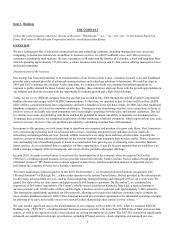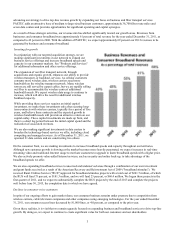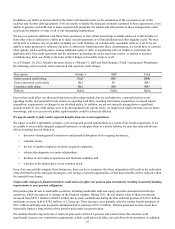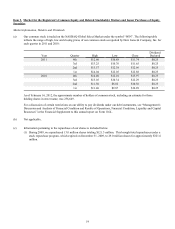Windstream 2011 Annual Report Download - page 84
Download and view the complete annual report
Please find page 84 of the 2011 Windstream annual report below. You can navigate through the pages in the report by either clicking on the pages listed below, or by using the keyword search tool below to find specific information within the annual report.
12
Item 1A. Risk Factors
Risks Relating to Our Business
The following discussion of “Risk Factors” identifies the most significant factors that may adversely affect our business, results
of operations or financial position. This information should be read in conjunction with “Management's Discussion and
Analysis of Financial Condition and Results of Operations” and the consolidated financial statements and related notes
included in this report. The following discussion of risks is not all-inclusive but is designed to highlight what we believe are
important factors to consider when evaluating our business and expectations. These factors could cause our future results to
differ materially from our historical results and from expectations reflected in forward-looking statements. Additionally, this
discussion should not be construed as a listing of risks by order of potential magnitude or probability to occur.
Competition in our business markets could adversely affect our results of operations and financial condition.
We serve business customers in markets across the country. Our significant competitors for business customers include other
communications providers and cable television companies. Competition in our business markets could adversely affect growth
in business revenues and ultimately have a material adverse impact on our results of operations and financial condition. If we
are unable compete effectively, we may be forced to lower prices or increase our sales and marketing expenses. In addition, we
may need to make significant capital expenditures in order to keep up with technological advances and offer competitive
services. For additional information, see the risk factor “Rapid changes in technology could affect our ability to compete for
business customers.”
In certain markets where we serve business customers, we lease significant amounts of network capacity in order to provide
service to our customers. We lease these facilities from companies competing directly with us for business customers. For
additional information, see the risk factor “In certain operating territories, we are dependent on other carriers to provide
facilities which we use to provide service to our customers."
Competition in our consumer service areas could reduce our market share and adversely affect our results of operations
and financial condition.
We face intense competitive pressures in our consumer service areas. If we continue to lose consumer access lines as we have
historically, our results of operations and financial condition could be adversely affected. During 2011, our consumer access
lines declined 4.0 percent.
Sources of competition include, but are not limited to, wireless companies, cable television companies and other
communications carriers. Many of our competitors, especially wireless and cable television companies, have advantages over
us, including substantially larger operational and financial resources, larger and more diverse networks, less stringent regulation
and superior brand recognition. For additional discussion regarding competition, see “Competition” in Item 1.
Cable television companies have aggressively expanded in our consumer markets, offering voice and high-speed Internet
services in addition to video services. Some of our customers have chosen to move to cable television providers for their voice,
high-speed Internet and television bundles. Cable television companies are subject to less stringent regulations than our
consumer operations. For more information, refer to the risk factor, “Our competitors, especially cable television companies, in
our consumer markets are subject to less stringent industry regulations.”
Wireless competition has contributed to a reduction in our access lines and generally has caused pricing pressure in the
industry. Some customers have chosen to stop using traditional wireline phone service and instead rely solely on wireless
service. We anticipate that this trend toward solely using wireless services will continue, particularly if wireless prices continue
to decline and the quality of wireless services improves.
Competition in our consumer markets could affect our revenues and profitability in several ways, including accelerated
consumer access line loss, reductions by customers in usage-based services or shifts to less profitable services and a need to
lower our prices on unregulated services or increase marketing expenses to stay competitive.
Rapid changes in technology could affect our ability to compete for business customers.
The technology used to deliver communications services has changed rapidly in the past and will likely continue to do so in the
future. If we are unable to keep up with such changes, we may not be able to offer competitive services to our business
customers. This could adversely affect our ability to compete for business customers, which, in turn, would adversely affect our
results of operations and financial condition.
























